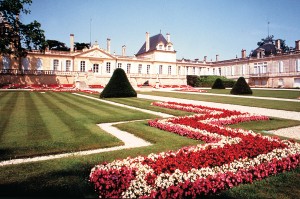An ultra mini Beychevelle vertical: 2000 and 1982, plus other jewels
February 13, 2011
As for the wine in bottle, could it punch higher than its current weight class? Given its fine terroir and potential – almost 80 hectares of vines on deep gravel in proximity to the river, the wine can sometimes seem underperforming. But there is no denying that recent investments in viticulture and in the vat room, by the two – until very recently – majority owners (Grands Millésimes de France – GMF, the French Civil Servants’ Pension Fund and the Japanese group Suntory) have marked some improvement in terms of consistency, especially in the last three or four vintages. [Newsflash! Just this month, the French group Castel has made a bid on 50% of the estate… Things are moving at Beychevelle!] The 2008, tasted from bottle in New York in January 2011, was lovely, for example. And winemaking director Philippe Blanc is very talented.
To be sure, Beychevelle does very well in excellent vintages, and thus constitutes (perhaps until the “Chinese” factor) a bargain. Such was the experience I had with the Beychevelle 2000. I bought six bottles en primeur for about $35 per bottle, and had opened one immediately upon arrival and liked it very much for its fine primary cassis fruit and excellent structure. I then opened another one in Berlin a few years later, but it had closed down to something more inexpressive, an experience to which fellow wine geek and poster extraordinaire Martin Zwick could attest. But now – and Martin, if you are reading – I can safely say that Beychevelle 2000 is the real deal. A fine wine from St Julien. When I first opened it ahead of a dinner with two wine merchants in Washington D.C., it altered between some earthy minerality and excellent cassis/cherry fruit. With time in glass over dinner (my duck, though delicious, was too sweet for the wine, and I should have ordered the more simple steak), it exuded fine complexity with more red fruit, licorice and a certain dominating creosote aspect that somewhat minimized the wine’s potential, which is clearly in need of being fully realised in 10 years. I only have three more bottles, and will not touch the next one – if all goes well – before 2020. If I want Beychevelle in the interim, better to procure a few 2002s, especially since the price of the 2000 has now approached $140 per bottle! The Chinese dragon-label effect?
Far better, today, and more complex was the Beychevelle 1982. Wow, now that was special, enjoyed in its prime, almost 30 years later. The aromatics combined leather, cedar, tobacco and a sweet damson like aspect on the mid palate preceding a structured, somewhat acidic but very floral finish. A wine that is drinking beautifully today. Its texture was at once fluid yet full, the tannins melted just right so that you felt the character of the wine, but it was very polished, very smooth. It does not match the concentration of, say, a Mouton Rothschild 1982, which I have had on several occasions over the last few years, or perhaps the complexity of the Figeac 1982, which I just recently enjoyed, but it was just a wondrous wine to enjoy now, without too much thought, and it would be most interesting to compare it to its neighbor accross the street, the Branaire Ducru 1982, which I have only enjoyed once, back in 2006.
The dinner and service at Siroc Restaurant in Washington D.C. was superb. I was joined by Paul Chaconas, Bordeaux wine buyer for Total Wine, that enormous wine chain mainly along the East Coast of the US, and Rod Haden, a representative of Tarras Vineyards in New Zealand. I had met Paul last year in Bordeaux at La Conseillante and interviewed him for an article that was published in Meiningers Wine Business International.
Paul generously brought the Beychevelle 1982. But he also brought a bottle of Jean Noel Gagnard Chassagne Montrachet Clos de Maltroie 1999 that was not prematurely oxidized. It exuded a certain candied orange rind flavor, some butterscotch but not overwhelming, with refined mineral notes on the palate and – most important perhaps – excellent grip and acidity on the palate, with lemon-lime notes refreshing the palate. I loved that white Burgundy, thank you Paul!
We ended things with a half bottle of Trimbach Clos St Hune VT 1989, thanks to Rod for bring this superb wine from Alsace. At first, I got mahoganey wood, but then a marzipan like aroma and flavor, and it just got more complex in glass: orange, toffee, tobacco, smoke, a hint of wet sock – just a hint – but complimented by “wet rock” and hints of Riesling like petrol, but just subtle hints. This was not an oily monster. In fact, any sock-like aromas gave way to freshness with time in glass, and even a certain iodine aspect, ending with a fine, slightly bitter lemon tonic finish. Overall, I think this wine is a bit young, and will reveal itself even better in a few years. For a recent video of co-owner Jean Trimbach, click HERE.
Stay tuned, as I will post more tasting notes on Beychevelle, as tasted over the last 5-7 years.


